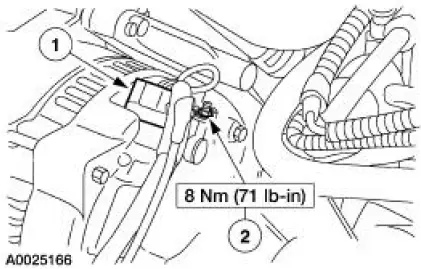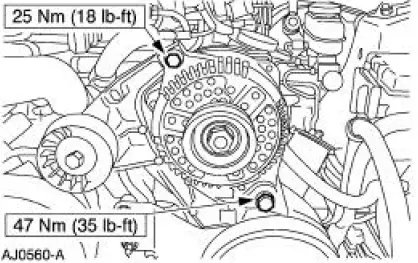Ford Mustang (1999-2004) Service Manual: Generator - 3.8L
Removal and Installation
1. Disconnect the battery (10655). For additional information, refer to Section.
2. Relieve the accessory drive belt (8620) tension and remove the belt from the generator pulley.
Leave the belt in place for reinstallation. For additional information, refer to Section.
3. CAUTION: This is a new style connector that has a press-to-release tab. Pulling on the tab could result in damage to the connector or harness.
Disconnect the generator (10300).
1. Disconnect the generator electrical connectors.
2. Remove the battery positive cable nut.

4. Remove the generator.
- Remove the upper and lower generator bolts.

5. To install, reverse the removal procedure.
 Generator and Regulator
Generator and Regulator
General Specifications
Torque Specifications
Generator
The charging system consists of the:
generator (GEN)
internal voltage regulator
The generator has an internal voltage regulato ...
 Generator - 4.6L 2V
Generator - 4.6L 2V
Removal and Installation
1. Disconnect the battery (10655). For additional information, refer
to Section.
2. Relieve the accessory drive belt (8620) tension and remove the belt
from the gen ...
Other materials:
Pulley - CIII Pump
Special Tool(s)
Pump Pulley Replacer
211-185 (T91P-3A733-A)
Pump Pulley Remover
211-016 (T69L-10300-B)
Removal
1. Remove the drive belt.
2. Raise and support the vehicle.
3. Using the special tool, remove the pulley.
Inspect the p ...
Air Distribution
NOTE: The air distribution system of this vehicle cannot be equipped
with a cabin air filter.
There are two sources of air available to the air distribution system:
outside air
recirculated air
Recirculated air is only used during MAX A/C.
Air distribut ...
Support Straps
Removal
WARNING: Do not smoke, carry lighted tobacco or an open flame of any
type when
working on or near any fuel-related components. Highly flammable mixtures are
always present
and may be ignited, possibly resulting in personal injury.
WARNING: Fuel suppl ...
